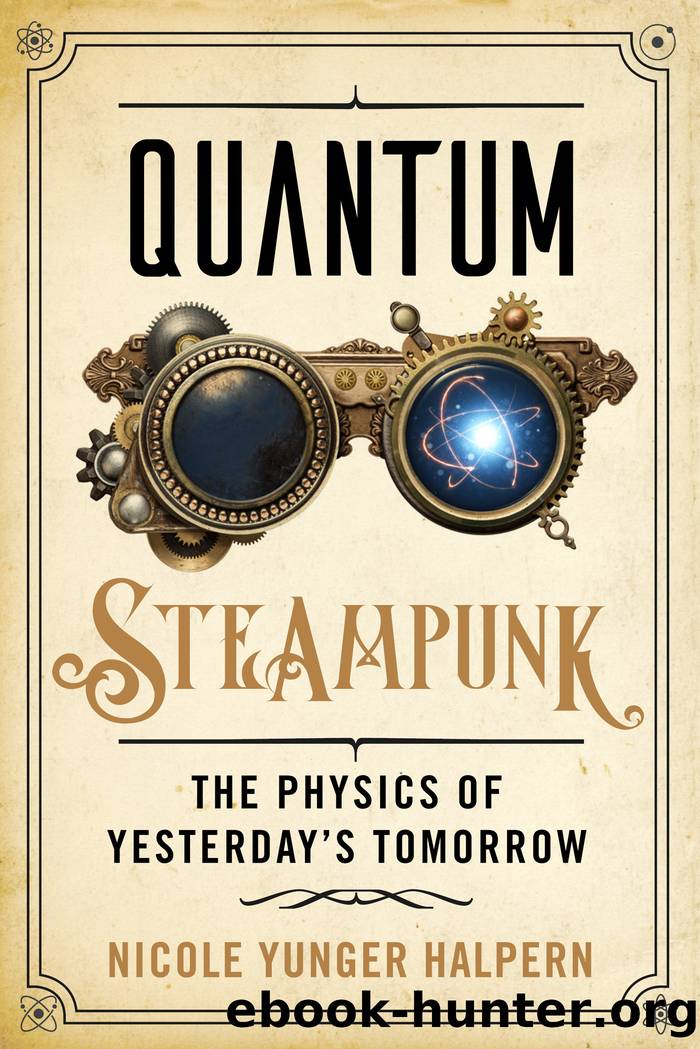Quantum Steampunk by Nicole Yunger Halpern

Author:Nicole Yunger Halpern
Language: eng
Format: epub
Publisher: Johns Hopkins University Press
Published: 2022-04-15T00:00:00+00:00
These quantum clocks enable us to measure time accurately, but they arenât autonomous: someoneâan external controllerâmeasures the atoms and adjusts the laser. What sort of a system could serve as an autonomous quantum clock?
Wolfgang Pauli pondered this question during the 1920s.4â6 Pauliâs exclusion principle explained why a two-fermion Szilard engine canât perform as much work as a classical engine or a bosonic engine (under certain assumptions). Pauli was an Austrian-American physicist whose interests extended from quantum physics to psychology and philosophy. He homed in on simple, yet fundamental conceptsâand what is time, if not fundamental?
Pauli theorized about autonomous quantum clocks (Iâll drop the autonomous from now on). The ideal quantum clock, he wrote, has a time observable. Observable is the physics name for a measurable property of a quantum system. Weâve discussed several observablesâenergy, position, momentum, and spin componentsâalthough I havenât called them observables till now. An ideal quantum clock could occupy a quantum state in which the time observable has a well-defined value.
In such a state, the energy wouldnât have a well-defined value, thanks to quantum uncertainty. According to the uncertainty principle, an electron with a well-defined position is in a superposition of all possible momenta. The more well-defined the electronâs position, the less well-defined the momentum. Energy and time participate in a similar trade-off. So, a quantum system with a well-defined time would be in a superposition of all possible energies. This superposition would have an important property: Imagine preparing a system in this superposition and then measuring the energy. Your probability of obtaining one possible outcome equals your probability of obtaining any other possible outcome. That is, a system with a well-defined time is in a superposition spread evenly across all possible energies.
This fact reveals a trade-off between timekeeping and work extraction. Suppose that you have one quantum system, from which you want to extract work or which will keep time. A system performs work reliably if you can predict roughly how much work itâll provide. You can predict accurately if you know how much energy the system hasâif the system has a well-defined energy. So, a well-defined energy often facilitates work extraction, while a poorly defined energy facilitates timekeeping. The ability to tell time trades off with the ability to provide work in quantum thermodynamics.
Pauli proved that no quantum system can have a time observable. If a system did, it could have an infinitely negative amount of energy. Having an infinitely negative amount of energy is impossible in our world. So, our world doesnât accommodate time observablesâor ideal quantum clocks.
Download
This site does not store any files on its server. We only index and link to content provided by other sites. Please contact the content providers to delete copyright contents if any and email us, we'll remove relevant links or contents immediately.
Essentials of Geology by Stephen Marshak(389)
Spectral Geometry and Inverse Scattering Theory by Huaian Diao & Hongyu Liu(280)
Probably Overthinking It: How to Use Data to Answer Questions, Avoid Statistical Traps, and Make Better Decisions by Allen B. Downey(269)
The Readable Darwin by Pechenik Jan A.;(263)
Hydrocarbon transformations in sediments from the Cathedral Hill hydrothermal vent complex at Guaymas Basin, Gulf of California ââ¬â A chemometric study of shallow seep architecture by unknow(262)
How to succeed in EPSO numerical reasoning tests by Franco Reverte José María(239)
Great Ways to Learn Anatomy and Physiology by McKissock Charmaine;(232)
Quantum International Relations by James Der Derian(231)
Research and Publication Ethics by Santosh Kumar Yadav(231)
Mathematical Models in Economics. Lections by Shananin(230)
Weathering: Types, Processes and Effects: Types, Processes and Effects by Matthew J. J. Colon(226)
Dark Matter in the Universe by John N. Bahcall(223)
Fusion of Defects by Arthur Bartels; Christopher Douglas; André Henriques(214)
Cosmic Rays by Alessandro De Angelis(211)
Sampling by Lohr Sharon L.;(205)
Mathematics Booster-1 by Singh Manoj Kumar(205)
The Structure of Scientific Inference by Mary B. Hesse(204)
Pearls from a Lost City: The LVOV School of Mathematics (History of Mathematics) (History of Mathematics, 40) by Roman Duda(199)
Flora Unveiled by Taiz Lincoln;Taiz Lee;(190)
